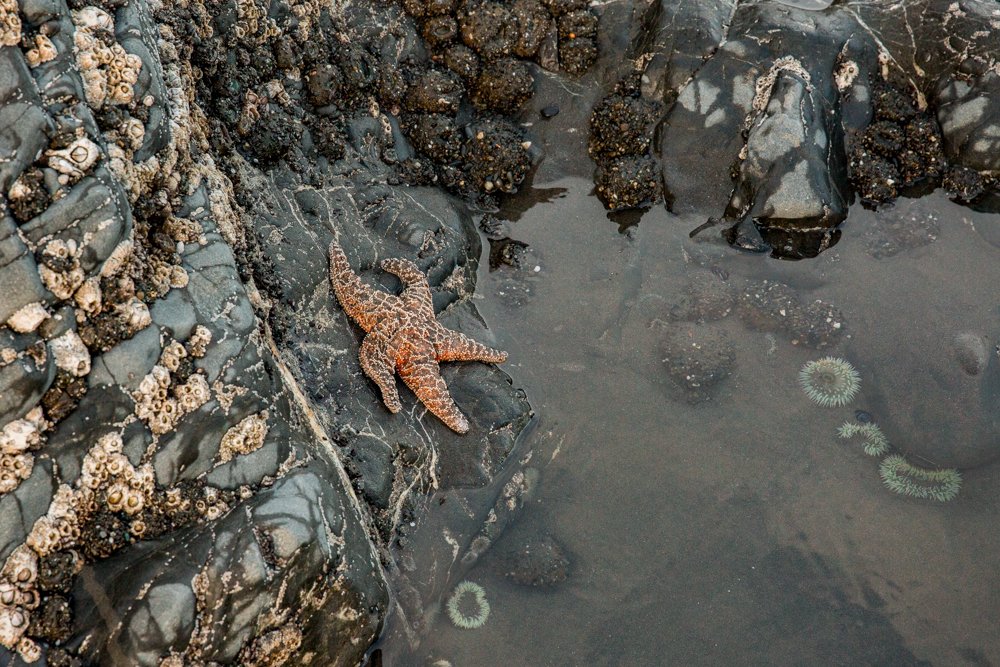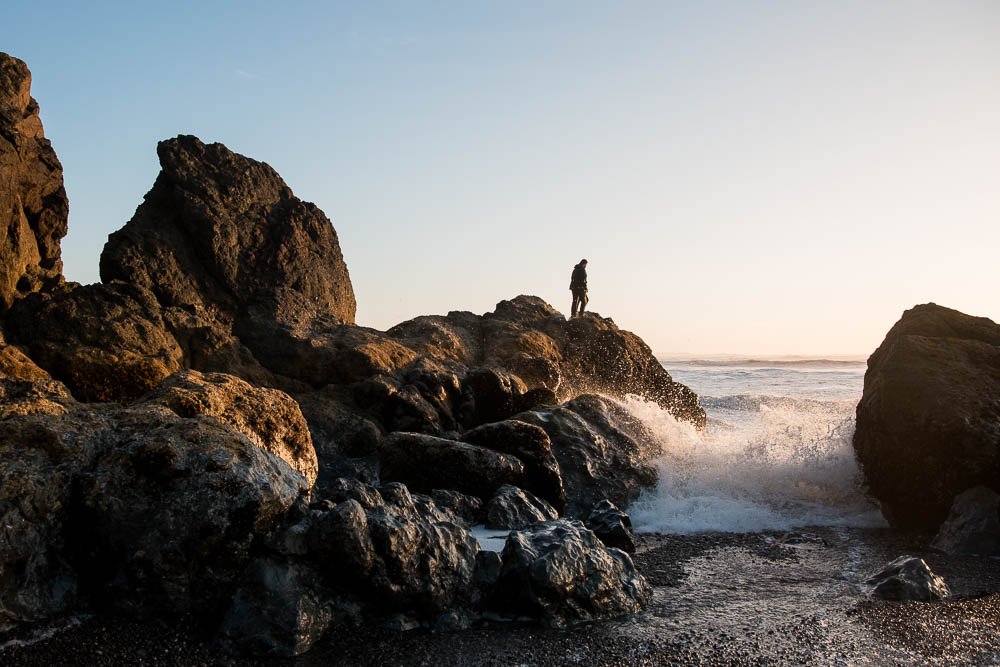How to Tide Pool in the Pacific Northwest
Tide pooling is an essential part of visiting the coast in the Pacific Northwest. If you can find a good location and visit at low tides, you’ll have hours of free entertainment on your hands.
Below is everything you need to know to start tide pooling!
Check the tides
First, you need to time the tide right. Check the NOAA tide predictions for locations you’re interested in tide pooling at. For the best tide pooling, visit when tides are below -1. Arrive one hour before low tide is expected for the best conditions. After the tide starts coming in, the tide pools will become muddy looking as incoming waves disturb the pools.
Tide pool safety
For you
Keep an eye on the ocean
Do not turn your back to the ocean — there are sneaker waves! These waves are much larger than the other incoming waves and can sweep you into the sea. Watch the ocean and look for changes in the surf to spot sneaker waves before they reach the beach.
Tide traps
Some beaches have tide traps — areas with obstacles you can only go around at low tide. Once the tide comes back in, you can’t make it back around the obstacle. Research areas you’re interested in tide pooling and always monitor the tide.
Shi Shi Beach
Shoes
Tide pool areas are slippery, especially if rocks are covered in seaweed. It’s best to observe pools from the sand but you should also wear shoes with a good grip. Rain boots are our first choice here, but waterproof hiking boots, or close-toed water shoes work well, too. Since tide pools are in rocky areas, don’t go barefoot or wear sandals.
Click here for an Oregon coast packing list and here an Olympic National Park packing list.
Be prepared to get wet
Whether you plan on getting in the water or not, plan as if you’ll be getting wet. Pack a towel and a change of clothes and shoes in the car just in case you get splashed.
Bring layers
Beaches here in the Pacific Northwest usually aren’t very warm and tend to be chilly in the mornings and evenings. Bring warmer layers in case it’s colder than expected.
For the animals
To touch or not to touch?
Whether or not you should touch some of the animals in tide pools depends on the area. Research rules in the area you’re tide pooling in beforehand.
Okay to touch
In the Pacific Northwest, it’s usually okay to touch most animals. When touching, get your hand wet first, and touch gently with one finger. Do not poke, prod, or pry animals off a surface.
Our favorite animal to touch is the sea anemone when it’s open in the water. Its tentacles will stick to your fingers!
Sea anemones preparing for lower tides by pulling in their tentacles. Look closely here, some caught a meal!
Do NOT touch
Starfish
Touching starfish is how the sea star wasting disease spreads. This disease started in 2013, affecting 20 species of starfish, and the starfish are just now beginning to come back to the Pacific Northwest. Please refrain from touching starfish!
Crabs
Pick up a crab and you might get pinched. Hermit crabs tend to be a bit more friendly, but hold them close to the water and let them go if they show signs of distress.
Jellyfish
These can sting!
Barnacles
These are safe to touch, but they’re sharp. Beware of slipping near them because they will cut you.
Animals to look for:
Tidepool sculpin (fish)
Snails
Clams
Mussels
Barnacles
Crabs
Watch your step out of water too!
Hermit crabs
Sea cucumbers
Sea anemones
Sea urchins
Chiton
Can you find two chiton here? Need a hint? They are both on the largest rocks in the photo.
Nudibranchs (these are small — about the size of a fingernail)
Limpets
Starfish (don’t touch these — it spreads sea star wasting disease)
Jellyfish
Octopus (on rare occasions)
Tide pool etiquette
Go slowly
Walk carefully, be mindful of where you’re stepping and never walk in the tide pools. Slow down at each tide pool to notice smaller animals. You’ll see so much more if you take your time.
View of a tide pool from above — get down low and watch for movement to find life!
Walk carefully, even when you’re not near water because there is sea life everywhere — can you spot the two curled up anemones here?
Keep pets leashed
If the area you’re tide pooling at is dog friendly, keep them leashed and out of the tide pools.
Leave what you find
Everything is part of the ecosystem here. Please do not collect plants or animals, dead or alive.
Pack trash out
Of course you should pack out any trash you bring in, but if you find garbage on the beach, pack it out, too! Keeping our shores clean is a community effort.
Check out the crab inside the hole here
Do not feed the wildlife
Feeding the wildlife can disturb their natural hunting and foraging patterns. Please refrain from feeding birds and other animals.
Where to tide pool
Beaches with rock formations have the best tide pools. If you’re tide pooling in a state or national park, research if they have private or ranger-led tours for the best experience.
Best tide pooling Washington
The Olympic National Park
Shi Shi Beach, Neah Bay (hike or backpack)
Sand Point on the Ozette Triangle (hike or backpack)
Second Beach, Forks (hike)
Third Beach, Forks (hike)
Kalaloch Beach 4, Forks (hike)
Rialto Beach at the Hole in the Wall, Forks (hike)
Rialto Beach near the Hole in the Wall
Tongue Point at Salt Creek Recreation Area, Port Angles (steep stairs)
Best tide pooling in the greater Seattle area (you can tide pool on the Puget Sound, too!)
Carkeek Park, Seattle
Larrabee State Park, Bellingham
Edwards Point, Edmonds
Dash Point State Park, Federal Way
Titlow Beach, Tacoma
Special mention for the Seattle Aquarium — they have touch tanks!
Best tide pooling on the Oregon coast
Haystack Rock at Cannon Beach, Cannon Beach
Hug Point State Recreation Site, Arch Cape
Seal Rock State Recreation Site, Bayshore
Sunset Bay State Park, Coos Bay
Coquille Point, Bandon
Meyers Creek Beach, Gold Beach
Harris Beach State Park, Brookings
If you loved this blog, you’re going to love our blog all about how to whale watch too! Check it out here.
Search the blog for more adventures! Try searching for topics such as “backpacking”, “waterfalls”, or “national parks”.
























